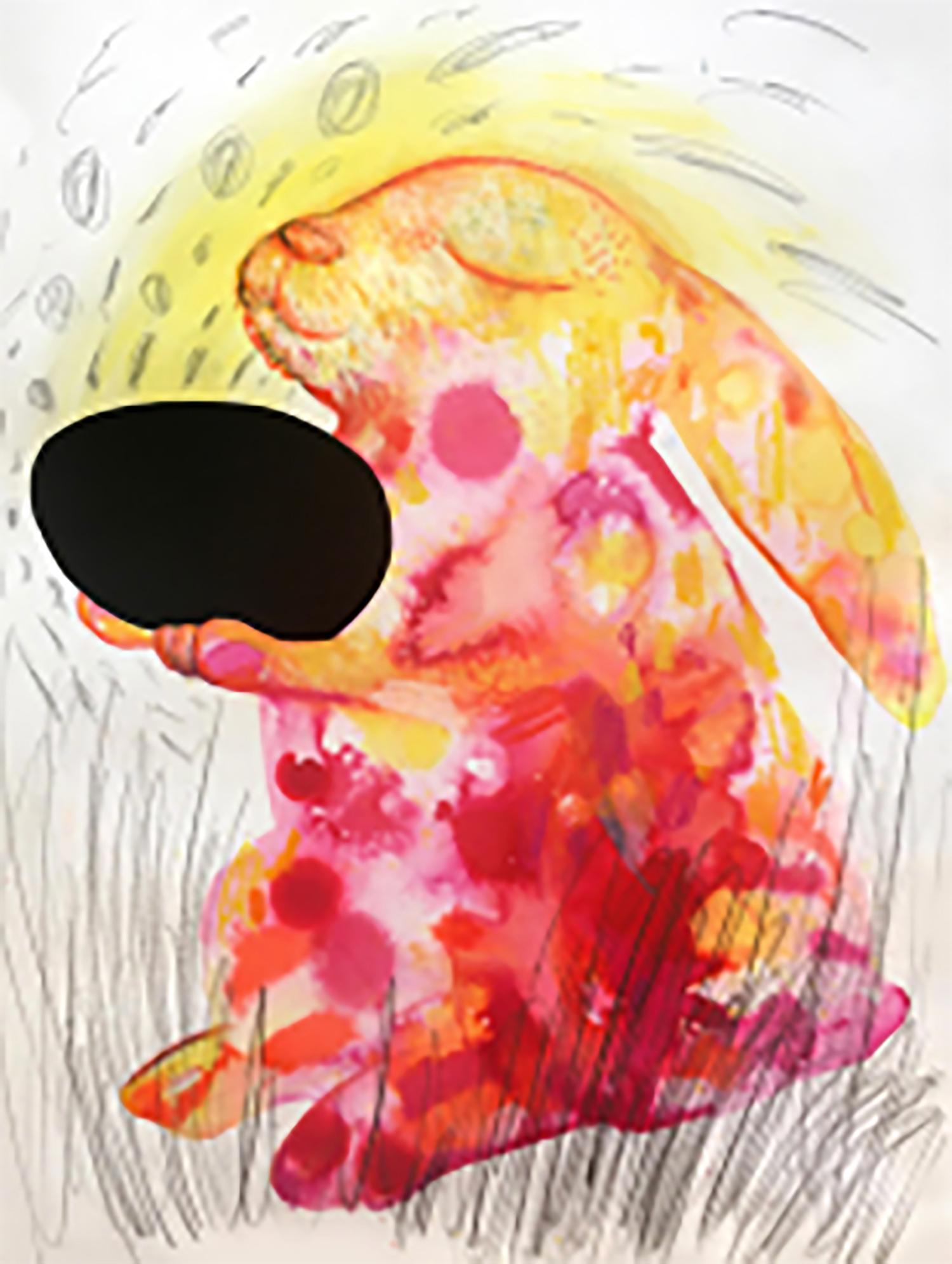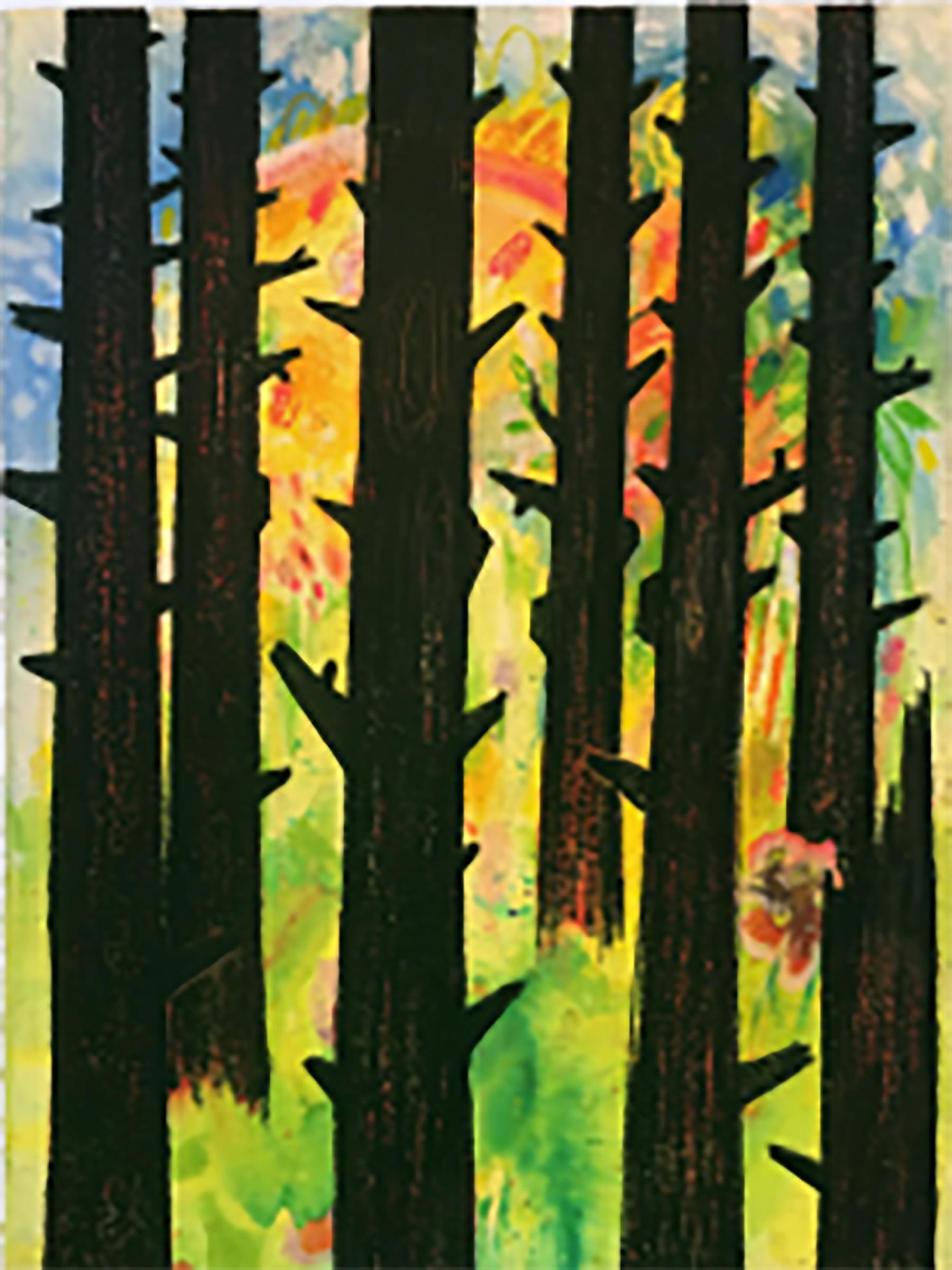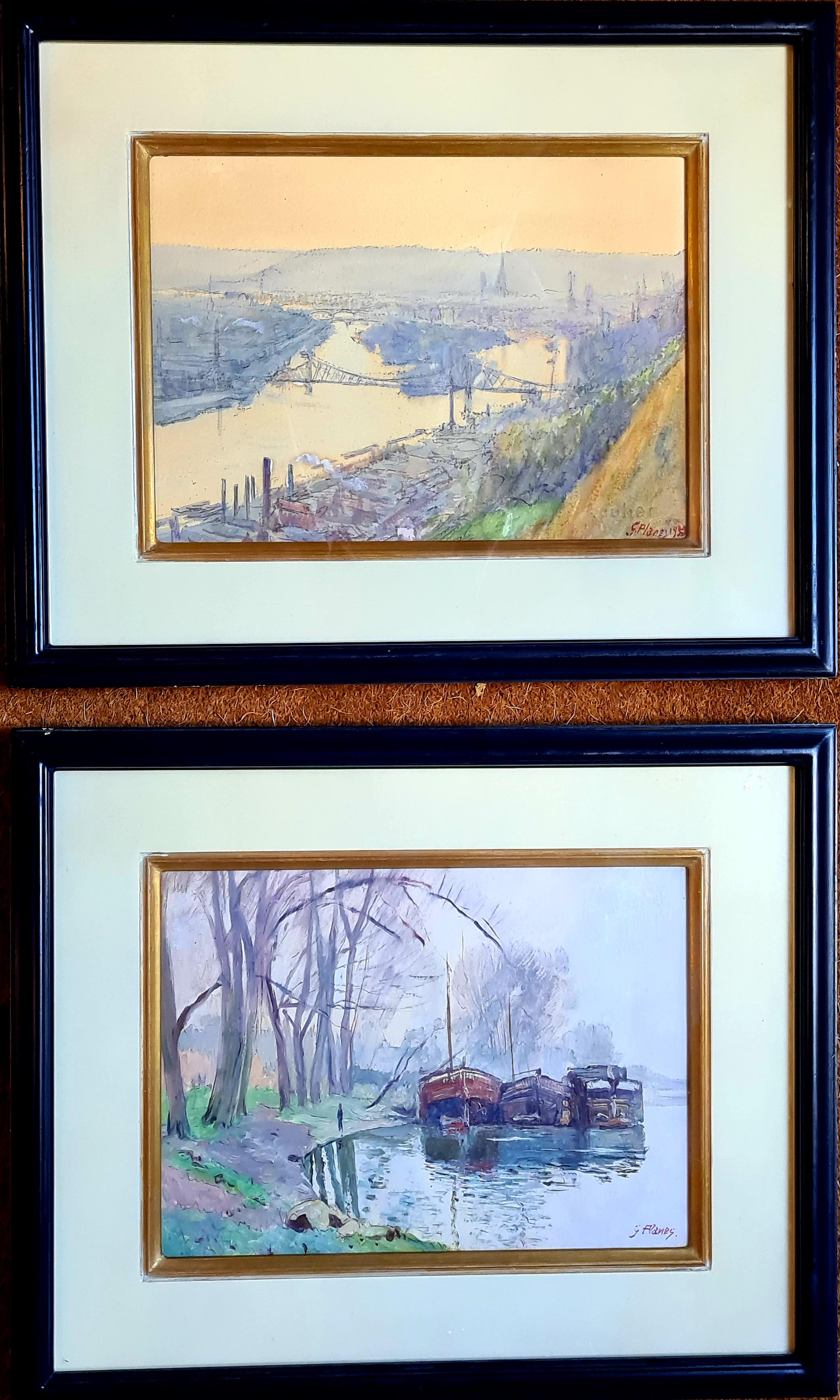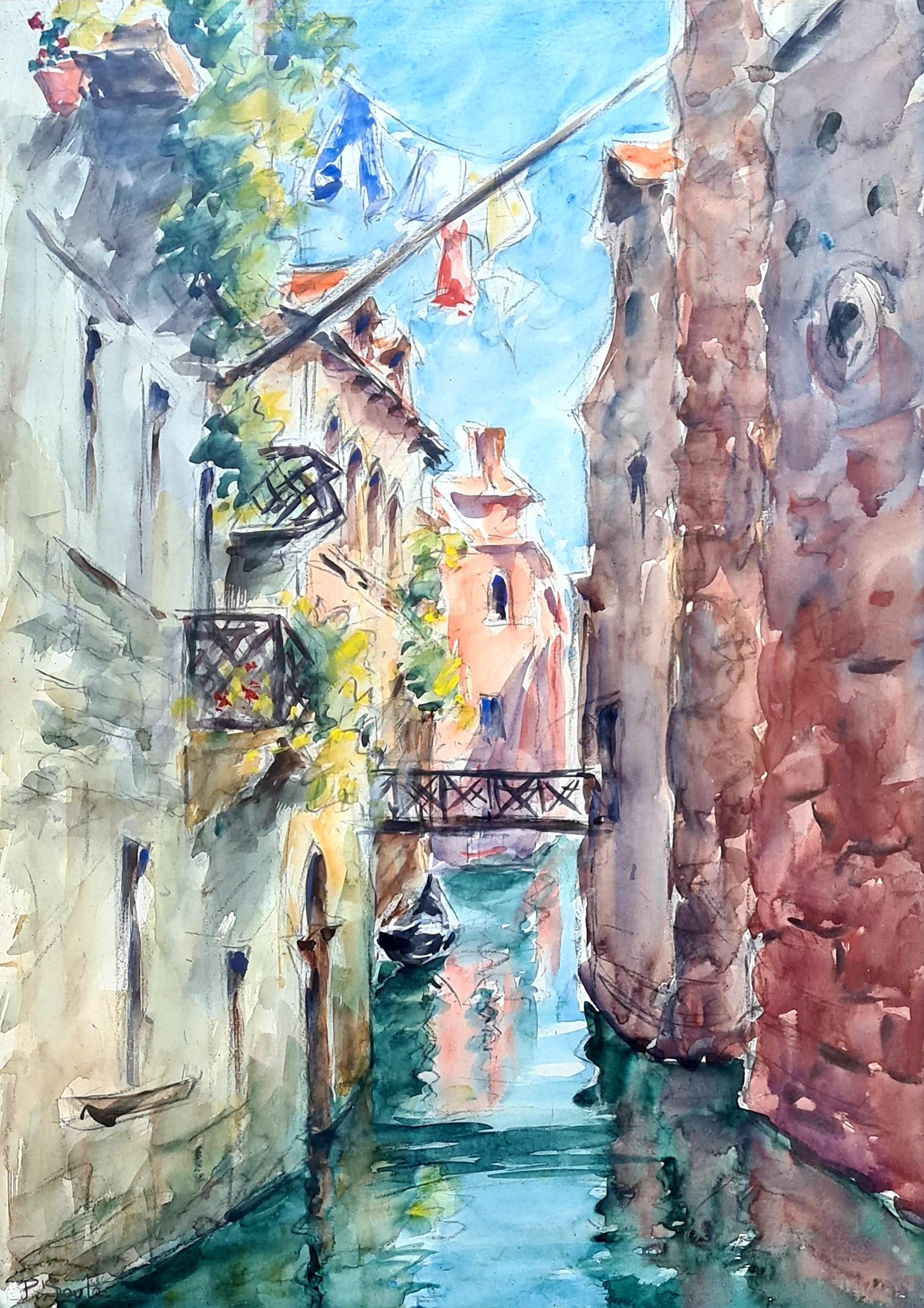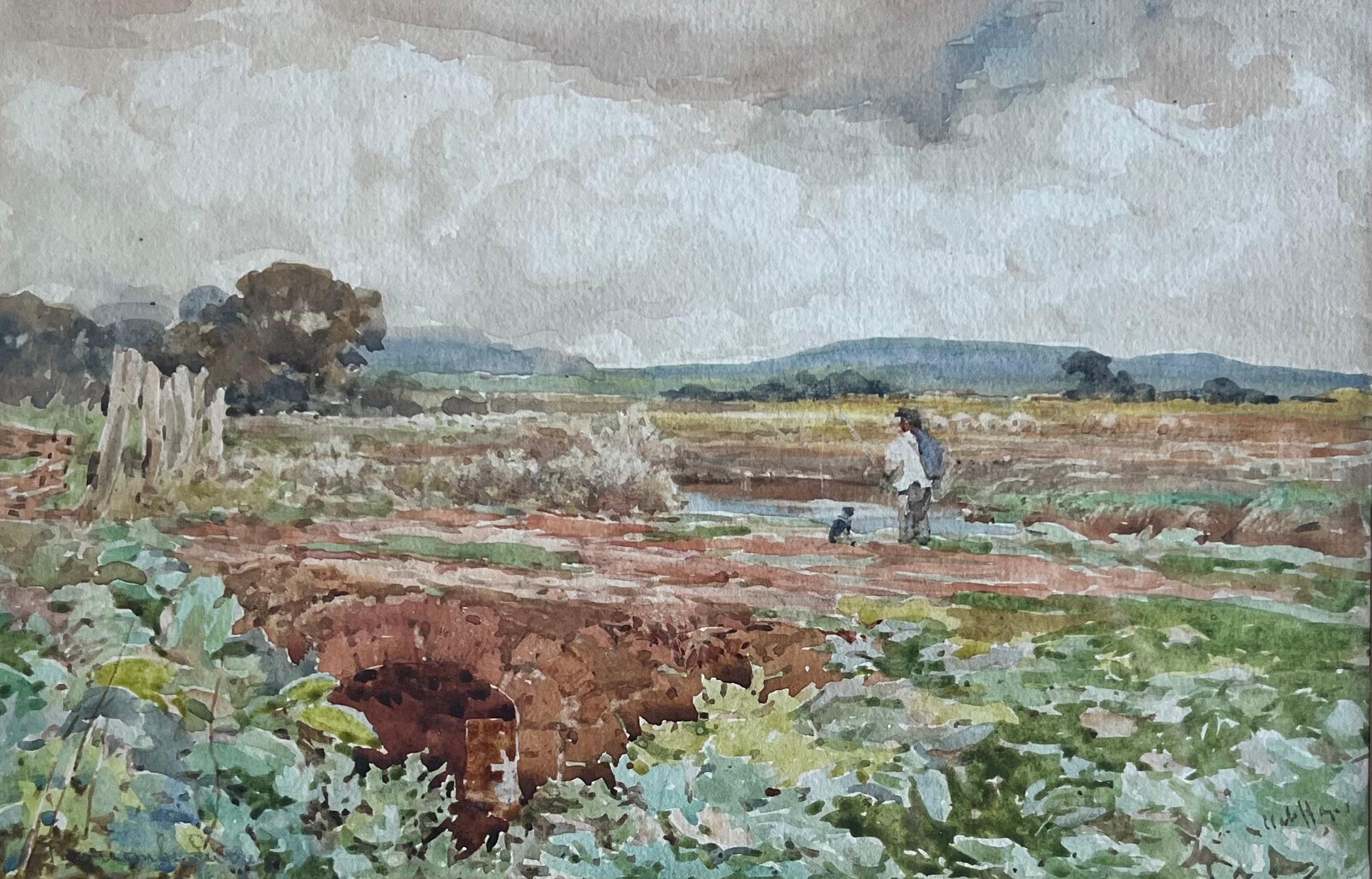Items Similar to "Tugboat at Dock, " Reginald Marsh, Modern WPA Industrial Ship
Want more images or videos?
Request additional images or videos from the seller
1 of 11
Reginald Marsh"Tugboat at Dock, " Reginald Marsh, Modern WPA Industrial Shipcirca 1937
circa 1937
About the Item
Reginald Marsh
Tugboat at Dock, circa 1937
Signed lower right
Watercolor and pencil on paper
13 3/4 x 20 inches
Housed in a Lowy frame.
Provenance:
Sotheby's, New York, March 1, 2006, Lot 113
D. Wigmore Fine Art, New York
Private Collection, New York
Shannon's, Summer Sale Fine Art Auction, June 25, 2020, Lot 6
Private Collection, New Jersey
Reginald Marsh was born in Paris, France in 1898. His family returned to the U.S. in 1900, settling in New Jersey. The Marsh family moved to New Rochelle, New York in 1914, where Reginald attended the Riverview Military Academy until 1915. Marsh spent his senior year at the Lawrenceville School where he drew for the school's annual. Marsh then attended Yale Art School in 1916-20 where he became the star illustrator for The Yale Record and, later, its art editor. In his newspaper work Marsh exhibited a graphic skill and a gift for pictorial humor.
On graduating from Yale in 1920, Marsh moved to New York City where he supported himself as a freelance illustrator for newspapers and magazines, such as Vanity Fair and Harper's Bazaar. In 1922, Marsh became a staff artist for The Daily News, first drawing city life and then a column of vaudeville illustrations. When The New Yorker began in 1925, Marsh became a staff member, contributing through 1931. These illustration jobs provided Marsh with a good income and a great amount of free time, which allowed him to study painting at the Art Students League on and off through the Twenties with Kenneth Hayes Miller, John Sloan and George Luks. When Marsh began to paint in earnest in 1923, he joined the Whitney Studio Club, where he had one-man exhibitions in 1924 and 1928.
In the early 1920's Marsh made his first trip to Coney Island on a project for Vanity Fair. He was instantly drawn to the raucous environment of extremes, capturing the boardwalks, beaches and sideshows in his sketch books. Marsh often remained in New York for the summer to spend time at Coney Island. The rest of the year Marsh painted industrial subjects. He also enjoyed recording the physical and social life of a newly commercialized city, focusing on taxi-dance halls, burlesque, Coney Island, subways and the Bowery. In 1929 Marsh took a studio near Union Square in New York where he remained for most of his life, roaming the streets with his sketch book. The same sketches he worked up for his newspaper and magazine illustrations found their way into his paintings.
The 1930s and 1940s were very successful for Marsh. He exhibited in most of the annual exhibitions of contemporary American art at the Whitney Museum of American Art (1924-1954), the Corcoran Gallery of Art (1932-1957), the Pennsylvania Academy of the Fine Arts (1932-1952), the Art Institute of Chicago (1928-1949) and the National Academy of Design (1927-1949). He also had many one-man exhibitions at the Frank K. Rehn Galleries in New York.
Marsh began teaching at the Art Students League in 1935 where he soon became one of the most popular teachers. In the spring of 1954, Marsh was chosen to receive the gold medal of the National Institute of Arts and Letters, an extremely high award in the American cultural world.
- Creator:Reginald Marsh (1898-1954, American)
- Creation Year:circa 1937
- Dimensions:Height: 21.5 in (54.61 cm)Width: 27.5 in (69.85 cm)
- Medium:
- Movement & Style:
- Period:
- Condition:
- Gallery Location:New York, NY
- Reference Number:1stDibs: LU1841212025422
About the Seller
5.0
Platinum Seller
These expertly vetted sellers are 1stDibs' most experienced sellers and are rated highest by our customers.
Established in 2021
1stDibs seller since 2022
59 sales on 1stDibs
Typical response time: 1 hour
- ShippingRetrieving quote...Ships From: Larchmont, NY
- Return PolicyA return for this item may be initiated within 3 days of delivery.
More From This SellerView All
- "Andes Mountains Peru South America, " Joseph Yoakum, Black Folk Art LandscapeBy Joseph YoakumLocated in New York, NYJoseph Yoakum Andes Mountains Peru So America, circa 1960s Colored pencil and ballpoint pen on paper 7 1/4 x 10 1/2 inches Provenance: Karen Lennox Gallery, Chicago Private Collection, South Dakota Yoakum began drawing in the early 1960s. Most of his work consists of radiantly colored landscapes with mountains, water, trees, and winding roads in abstract and complex configurations. his period of greatest activity — 1965 to 1970 — when he usually made one drawing a day. Yoakum maintained he had seen all the places represented in his drawings, a statement that may not be true in some instances. He traveled a great deal, beginning in his early teens when he ran away from home and became a circus handyman. Yoakum’s drawings can be considered memory images growing out of either actual or imagined experiences. All of his drawings have titles that grew longer and more specific over the years. He dated his works with a rubber stamp — an oddly impersonal, labor-saving device. Although Joseph Yoakum gave vastly different accounts of his background, he was, throughout his life, classified as an African American. Sometimes Yoakum claimed that he was a full-blooded “Nava-joe” Indian, one of twelve or thirteen children born to a farmer on an Indian reservation in Window Rock, Arizona. At other times he insisted that he was of African-American descent. He described his mother as a strong woman who was a doctor and knowledgeable in the use of herbal medicines. Yoakum’s family moved to Kansas City, Missouri, during his early childhood. His father was employed briefly in the railroad yards prior to settling permanently on a farm in nearby Walnut Grove...Category
1960s Folk Art Landscape Paintings
MaterialsPaper, Watercolor, Ballpoint Pen, Color Pencil
- "New York City Skyline View from the East River, " Lionel Reiss, Jewish ArtistBy Lionel ReissLocated in New York, NYLionel S. Reiss (1894 - 1988) New York City Skyline View from the East River Watercolor on paper 13 x 19 inches Signed lower left In describing his own style, Lionel Reiss wrote, “By nature, inclination, and training, I have long since recognized the fact that...I belong to the category of those who can only gladly affirm the reality of the world I live in.” Reiss’s subject matter was wide-ranging, including gritty New York scenes, landscapes of bucolic Bucks County, Pennsylvania, and seascapes around Gloucester, Massachusetts. However, it was as a painter of Jewish life—both in Israel and in Europe before World War II—that Reiss excelled. I.B. Singer, the Nobel Prize winner for Literature, noted that Reiss was “essentially an artist of the nineteenth century, and because of this he had the power and the courage to tell visually the story of a people.” Although Reiss was born in Jaroslaw, Poland, his family immigrated to the United States in 1898 when he was four years old. Reiss's family settled on New York City’s Lower East Side and he lived in the city for most of his life. Reiss attended the Art Students League and then worked as a commercial artist for newspapers and publishers. As art director for Metro-Goldwyn-Mayer, he supposedly created the studio’s famous lion logo. After World War I, Reiss became fascinated with Jewish life in the ‘Old World.’ In 1921 he left his advertising work and spent the next ten years traveling in Europe, the Middle East, and North Africa. Like noted Jewish photographers Alter Kacyzne and Roman Vishniac, Reiss depicted Jewish life in Poland prior to World War II. He later wrote, “My trip encompassed three main objectives: to make ethnic studies of Jewish types wherever I traveled; to paint and draw Jewish life, as I saw it and felt it, in all aspects; and to round out my work in Israel.” In Europe, Reiss recorded quotidian scenes in a variety of media and different settings such as Paris, Amsterdam, the Venice ghetto, the Jewish cemetery in Prague, and an array of shops, synagogues, streets, and marketplaces in the Jewish quarters of Warsaw, Lodz, Krakow, Lublin, Vilna, Ternopil, and Kovno. He paid great attention to details of dress, hair, and facial features, and his work became noted for its descriptive quality. A selection of Reiss’s portraits appeared in 1938 in his book My Models Were Jews. In this book, published on the eve of the Holocaust, Reiss argued that there was “no such thing as a ‘Jewish race’.” Instead, he claimed that the Jewish people were a cultural group with a great deal of diversity within and between Jewish communities around the world. Franz Boas...Category
1940s American Modern Landscape Drawings and Watercolors
MaterialsPaper, Watercolor
- "Sheepshead, Brooklyn, Long Island" Oscar Bluemner, Modernist WatercolorBy Oscar BluemnerLocated in New York, NYOscar Bluemner Sheepshead, Long Island, 1907 Signed with the artist's conjoined initials "OB" and dated "4-30 - 5 - 30" / "Aug 3, 07" Watercolor on paper 6 x 10 inches Provenance: J...Category
Early 1900s American Modern Landscape Drawings and Watercolors
MaterialsPaper, Watercolor
- "New England Landscape with Barns, " Andrew Nathaniel Wyeth, American ArtLocated in New York, NYAndrew Nathaniel Wyeth (American, b. 1948) New England Landscape with Barns, 1974 Watercolor and pencil on Bainbridge watercolor board 20 x 30 i...Category
1970s Landscape Drawings and Watercolors
MaterialsWatercolor, Board, Pencil
- "Afternoon Sun, " Ann Wyeth McCoy, Interior and LandscapeLocated in New York, NYAnn Wyeth McCoy (1915 - 2005) Afternoon Sun Watercolor on paper Sheet 24 x 18 inches Signed lower left Provenance: Somerville Manning Gallery Private ...Category
20th Century American Realist Landscape Drawings and Watercolors
MaterialsPaper, Watercolor
- "Gloucester Harbor at Sunset, " John Hare, Cape Ann, New England Watercolor ViewLocated in New York, NYJohn Hare Gloucester Harbor at Sunset, Massachusetts Signed lower right Watercolor on paper 16 x 12 inches John Cuthbert Hare, 1908-1978, was a watercolorist who painted boats, seascapes and harbor scenes. He was primarily associated New England, especially Cape Cod, Massachusetts where he spent his summers from 1938 to 1965. However, he was in Florida where he was a member of the St. Augustine Art Association, and other locations on the East Coast. It is likely Hare was born in New York City. He first studied commercial art in Brooklyn at the Pratt Institute and also studied at the Art Students League in Manhattan. He worked for Hearst newspapers corporation, and in 1933 married. In the next few years, he and his wife traveled extensively, camping and painting and exhibiting his work in galleries. In 1935, they visited St. Augustine and an exhibition of his watercolors was held there in the old bank...Category
Mid-20th Century Impressionist Landscape Drawings and Watercolors
MaterialsPaper, Watercolor
You May Also Like
- Gift, 2020, watercolor, oil pastel, pink, orange, rabbit, ink, fantasyBy Shamona StokesLocated in Jersey City, NJGift, 2020, watercolor, oil pastel, pink, orange, ink, fantasy, rabbit.Category
2010s Contemporary Landscape Paintings
MaterialsPaper, Oil Pastel, Ink, Watercolor, Graphite
- Anthemusa, 2020, watercolor, oil pastel, green, landscape, ink, fantasy, blueBy Shamona StokesLocated in Jersey City, NJAnthemusa, 2020, watercolor, oil pastel, green, landscape, ink, fantasy.Category
2010s Contemporary Landscape Paintings
MaterialsOil Pastel, Ink, Acrylic, Watercolor, Color Pencil, Graphite, Paper
- Hopeful Spring, 2020, watercolor, oil pastel, green, landscape, fantasy, treesBy Shamona StokesLocated in Jersey City, NJHopeful Spring, 2020, watercolor, oil pastel, green, landscape, fantasy, trees.Category
2010s Contemporary Landscape Paintings
MaterialsPaper, Oil Pastel, Ink, Acrylic, Watercolor, Color Pencil, Graphite
- A Canal in Venice, Hanging Out The Washing......Located in Cotignac, FRA watercolour on paper view of a canal in Venice by French artist Paule Soulé. The pain ting is signed bottom right and presented in a gilt and painted wood frame under glass. A cha...Category
Early 20th Century Impressionist Landscape Drawings and Watercolors
MaterialsWatercolor, Pencil, Paper
- Pair of French Impressionist Paintings, The City of Rouen and the River BargesLocated in Cotignac, FRA pair of French Impressionist landscape views by Georges Planes. (Dimensions given are for each painting.) The first painting: is an early 20th Century drawing and watercolour view...Category
Early 20th Century Impressionist Landscape Paintings
MaterialsPaper, Oil, Watercolor, Board, Pencil
- English watercolour of a fisherman and his dogLocated in Harkstead, GBA very attractive rural scene of a fisherman and his dog on a riverbank, in very good colour and an appealing composition. Claude Hayes (1852-1922) A fisherman and his dog by a riverbank Signed Watercolour with touches of pencil 6½ x 10 inches, image only 13 x 16 inches with the frame Claude Hayes was a Dublin born painter who to avoid his father's wish to make a businessman of him ran away to sea and served on the Golden Fleece, one of the transports used in the Abyssinian expedition of 1867-68, and also spent a year in the United States. Returning to London, he studied art at Heatherley's and the Royal Academy Schools, and then in Antwerp, under Charles Verlat. He worked in Hampshire with James Aumonier and also in Surrey with William Charles Estall, whose sister he married. Hayes exhibited widely in London and provincial centres, and was elected a member of the Royal Institute of Painters in Water Colours in 1886, the Royal Institute of Oil Painters in 1883, and the Royal Scottish Society of Painters in Watercolour, 1902. He also showed at the RA, RBSA, Brook Street Art Gallery, Dudley Gallery, FAS, GI, Grosvenor Gallery, Walker Art Gallery, Liverpool, MAFA, RBA, RHA, Ridley Art Club, RSW and Walker's Gallery, London. In 1912, Claude Hayes represented England at the Venice Biennale. His work is in various public collections in England and Ireland including the Ulster Museum, Museums Sheffield, Torre Abbey Museum and the Leeds City Art Gallery. His father was the artist Edwin Hayes.Category
Late 19th Century Victorian Landscape Drawings and Watercolors
MaterialsWatercolor, Pencil, Paper
Recently Viewed
View AllMore Ways To Browse
Gold Ship
Framed Ships Art
Ship French
3 Ships
Industrial Design Art
Vintage Industrial Studio
Ship Remain
Industrial Landscape Paintings
Star Ship
New York Worlds Fair 1939
American School Ship
Marshes Painting
Chicago Industrial
Vintage Family Illustration
Vintage City Sketches
Industrial Design Book
Jersey Island
Paintings Of A Marsh
